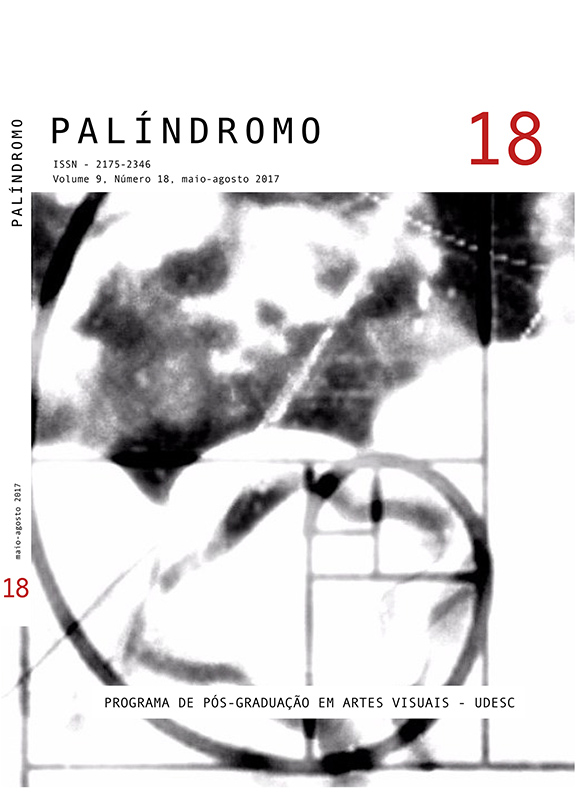In the gaps of the scopic regime
DOI:
https://doi.org/10.5965/2175234609182017186Keywords:
functional blindness, antiocularcentric thought, Luiz Henrique Schwanke, Cildo MeirelesAbstract
The present article seeks to provoke plausible ruptures in the current of thought proposed by the scopic regime through the study of blindness in the arts, particularly functional blindness and its metaphorical space. Thus, this text puts in evidence authors such as Georges Bataille and Jacques Lacan, and artists such as Luiz Henrique Schwanke – and his works Light Paving Stone (1990) and Light Cube (1991) – and Cildo Meireles with his work Blind Mirror (1970). Finally, the article was basically divided in two parts titled respectively: The Blinding Light: from Bataille to Schwanke and The mirror experience in Lacan and Cildo Meireles. Ultimately, two books were used as a basis for the presented reflection: Downcast eyes: the denigration of vision in twentieth century French thought by Martin Jay and Blindness and Visual Culture: An Eyewitness Account by Georgina Kleege.
Downloads
References
BAHIA, L. H. F. Cegueira e Artes Visuais: paradoxos e implicações. Dissertação (Mestrado) – Universidade do Estado de Santa Catarina, Centro de Artes, Programa de Pós-Graduação em Artes, Florianópolis, 2016.
BATAILLE, G. História do olho. Tradução de Eliane Robert Moraes. São Paulo: Cosac & Naify, 2003.
BELL, J. Uma nova história da arte. Tradução de Roger Maioli. São Paulo: Editora Martins Fontes, 2008.
BORGES, A. C.. Georges Bataille: imagens do êxtase. Fevereiro, nº 9, n.p. Fortaleza – São Paulo: Agulha, Revista de Cultura, 2001. Disponível em: <http://www.jornalde-poesia.jor.br/ag9bataille.htm>. Acesso em: 14 maio 2016.
FONTCUBERTA, J. A câmera de Pandora: a fotografi@ depois da fotografia. Tradução de Maria Alzira Brum. São Paulo: Editora G. Gilli, 2012.
FOUCAULT, M. A Arqueologia do saber. Tradução de Luiz Felipe Baeta Neves. 7ª edição. Rio de Janeiro: Forense Universitária, 2008.
_____________ As palavras e as coisas: uma arqueologia das ciências humanas. Tradução de Salma Tannus Muchail. 8ª edição. São Paulo: Martins Fontes, 1999. (Coleção tópicos).
_____________ Estética: literatura e pintura, música e cinema. Organização de Manoel Barros de Motta e tradução de Inês Autran Dourado Barbosa. 2ª edição, Ditos e Escritos, Volume III. Rio de Janeiro: Forense Universitária, 2009.
GINZBURG, Jaime. Cegueira e literatura. In: VECCHI, Roberto; FINAZZI-AGRÒ, Ettore. Formas e mediações do trágico moderno: uma leitura do Brasil. 1ª edição, volume II, cap. 1.6, p. 89-98. São Paulo: Unimarco Editora, 2004.
GONÇALVES FILHO, A. Primeira individual: 25 anos de crítica de arte. São Paulo: Cosac Naify, 2009.
HERKENHOFF, P. Cildo Meireles, geografia do Brasil. Rio de Janeiro: Artviva Produção Cultural, 2001.
JAHN, A. R. M.; LAMAS, N. de C. O ecossistema poético de Luiz Henrique Schwanke. 22º Encontro Nacional Anpap, Outubro, p. 132-147. Belém: Anais Anpap, 2013. Disponível em: <http://www.anpap.org.br/anais/2013/ANAIS/comites/htca/Alena%20Rizi%20MArmo%20Jahn%20e%20Nadja%20de%20Carvalho%20Lamas.pdf>. Acesso em: 18 maio 2016.
JAY, M. Ojos Abatidos: la denigración de la visión en el pensamiento francés del siglo XX. Tradução de Francisco López Martín. Madri, Espanha: Editora Akal, S.A., 2007. Tradução nossa.
KLEEGE, G. Blindness and Visual Culture: An Eyewitness Account. In: DAVIS, Lennard J.. The Disability Studies Reader. 4ª edição, cap. 32, p. 447-455. New York: Routledge, 2013. Tradução nossa.
LAMAS, N. de C.. Revisitamento“na” e “da” obra de Schwanke. Tese em Artes Visuais; orientadora Doutora Icleia Borsa Cattani. Porto Alegre: UFRGS, 2005.
NUCCI, M. G.; DALGALARRONDO, P. Automutilação ocular: relato de seis casos de enucleação ocular. Junho, vol. 22, nº 2, p. 80-86. São Paulo: Revista Brasileira de Psiquiatria, 2002. Disponível em: <http://www.scielo.br/scielo.php?script=sci_art-text&pid=S1516-44462000000200009>. Acesso em: 18 maio 2016.
SACKS, O. O olhar da mente. Tradução de Laura Teixeira Motta. São Paulo: Companhia das Letras, 2010.
SARAMAGO, J. Ensaio sobre a cegueira. São Paulo: Companhia das Letras, 1996.
SAINT-EXUPÉRY, A. de. O Pequeno Príncipe. Tradução de Frei Betto. São Paulo: Geração Editorial, 2015.
SOUZA, E. A. M. de. Blindhotland. In: MEIRELES, Cildo. Cildo Meireles. 1ª edição, cap. 1, p. 30-37. Rio de Janeiro: FUNARTE, 1981.
SOUZA, J. P. de. Teorias da Tradução: uma visão integrada. Janeiro/Dezembro, vol. 1/2, nº 20, p. 51-67. Revista de Letras, 1998. Disponível em: <http://www.revistadeletras.ufc.br/rl20Art09.pdf>. Acesso em: 21 agosto 2015.
TESSLER, Élida. Cegos conduzindo Cegos: algumas parábolas e outras incontinências do visual. Porto Alegre: Catálogo MARGS, 2001. 23 de agosto a 30 de setembro.
Vários autores. Arte Contemporânea: salão Luiz Henrique Schwanke. Jaraguá do Sul: Sociedade Cultura Artística, 2002.
Documentário. À luz de Schwanke. Direção: Ivaldo Brasil Jr. e Mauricio Venturi; Roteiro: Ivaldo Brasil Jr. e Kátia Klock. Joinville: Contraponto, 2008. 17 min. Parte em especial: <https://www.youtube.com/watch?v=fTEzlkRZI7w>. Acesso em: 18 maio 2016.
Downloads
Published
How to Cite
Issue
Section
License
Copyright (c) 2017 Palíndromo

This work is licensed under a Creative Commons Attribution 4.0 International License.
COPYRIGHT STATEMENT
The articles published by the magazine are free to use, intended for academic and non-commercial applications. Copyright is all assigned to the magazine. The articles whose authors are identified represent the expression from the point of view of their authors and not the official position of Palíndromo Magazine. The author (s) commits to whenever they publish material referring to the article published in Palíndromo mention this publication as follows:
This article was originally published by Palíndromo magazine in its volume (place the volume), number (place the number) in the year of (place the year) and can be accessed at: http://www.revistas.udesc.br/index.php/palindromo


